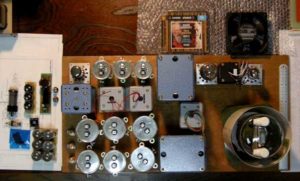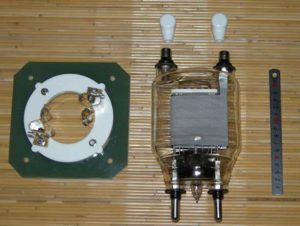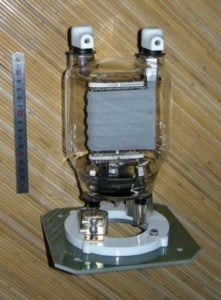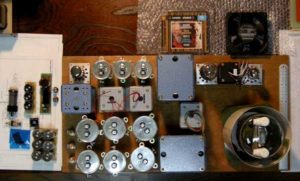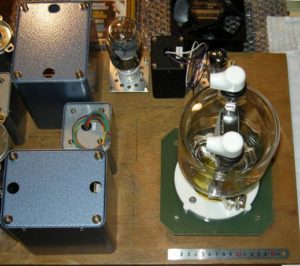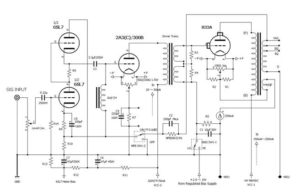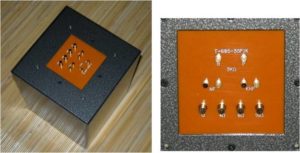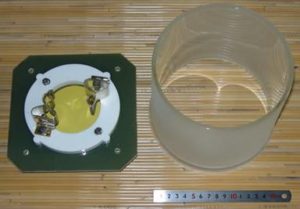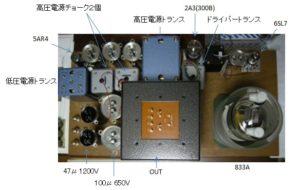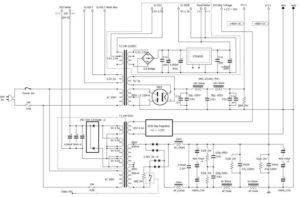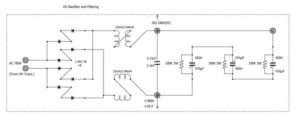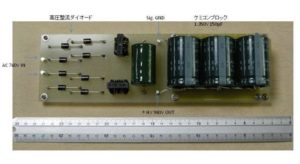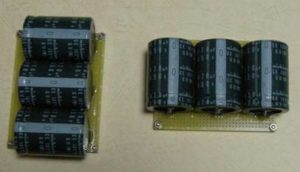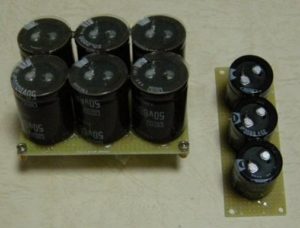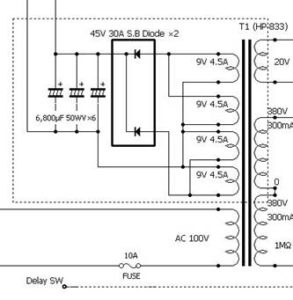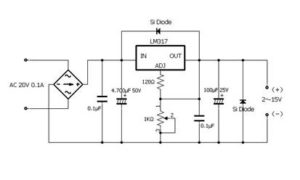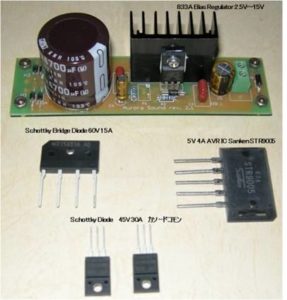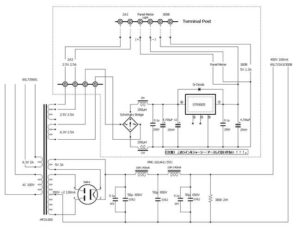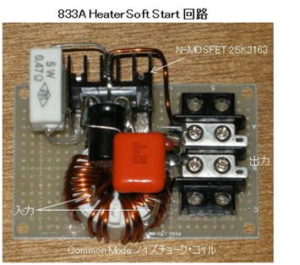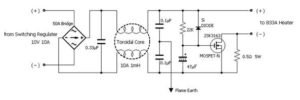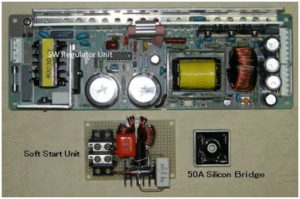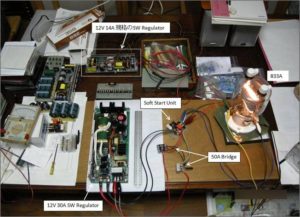■ Mr. Kashiwazaki S Production 833A amp.for Hartsfield ■
Amplifier production for Hartsfield production
Part 1: Amplifier driving JBL Hartsfield
Initially: The fact that JBL Hartsfield is available has come to light,
Well, it was the beginning of my attempt to devise a draft specially designed for the coat.
Although it seems that it is a vacuum tube now,
Even Koshi has made several semiconductor amplifiers such as Tr, MOS-FET or the like,
I was asked to listen while switching semiconductor manufacturers from overseas manufacturers,
It remained in the room only unnoticed, only a vacuum tube amp became several units.
As a result, the amplifier to be created this time is also a vacuum tube.
There are also various types of vacuum tube amp, but the quickest thing is to organize a kit,
The kit can not answer this demand,
It is departure from choosing the output tube of the tube amp.
When I remember this and talk, it will be long,
The conclusion is that RCA decided on the original air-cooled transmission tube 833A.
About 30 years ago this ball was doing Amagami Amano wireless,
We acquired only one for the purpose of creating a 14-MHz band mono band amplifier,
A vacuum tube that had been planned as it was.
Although it seems to go against the world as it is headed for power saving,
I found it from the storeroom and watching me a lot, in a very cocky style,
I felt like asking something to me,
I decided to make amps this time.
It took about one year since I got parts collection like this.
There was a prospect that most parts can be obtained so far,
There are things that have not arrived yet, some that are custom-made and time-consuming.
With this amp that blows a breath on this sphere,
I tried arranging the parts I got so far on one board,
With considerable weight,
W: 340 mm, D: 680 mm, H: about 350 mm, and it became large with a caster.
Weight is also transformer, main parts only, MONO 1 unit to 45 kg.
It is not very lonely alone.
But I think that this horsepower is necessary to drive Harts.
An output pipe 833 A with an adapter attached so that it can be mounted on a socket and mounted as a chassis
I tried to upgrade the image in which each part making up this amplifier was arranged on a flat plate.
1
833 A vacuum tube, plate, grid cap and heater socket
On the right is the scale of 15 cm
2
I made my own heater / socket adapter and attached it to the chassis in this state
Vacuum tube 833A.
3
I lay out the main parts on one flat plate
Because 833 A is air-cooled
Scheduled to install glass tube chimney
(I tried to cover a dummy made of cardboard because it has not been completed yet from the special glass workshop)
What is visible to the left,
833 A Heater DC ignition Chemi-con block for smoothing,
The substrate is a bias stabilizing power supply
The right china is 30 cm scale
I arranged the main parts that make up the amplifier. I understand the whole situation,
It looks big and heavy, is not it?
I’d appreciate it if you can make me laugh, “I have an idiot that makes such a stupid amp at the moment.”
第1部分
放大器驅動JBL Hartsfield
最初:JBL Hartsfield可用的事實已經曝光,
好吧,這是我嘗試設計專門為大衣設計的草稿的開始。
雖然現在看來它是真空管,
甚至Koshi也製造了幾種半導體放大器,如Tr,MOS-FET等,
我被要求在從海外製造商轉換半導體製造商的同時傾聽
它只留在房間裡沒有被注意到,只有一個真空電子管放大器成了幾個單元。
結果,此次創建的放大器也是真空管。
還有各種類型的真空管放大器,但最快的是組織一個套件,
該套件無法滿足這一需求,
這與選擇電子管放大器的輸出管不同。
當我記得這個並且說話時,它會很長,
結論是RCA決定採用原裝風冷傳動管833A。
大約30年前,這個球正在做Amagami Amano無線,
我們只購買了一個用於創建14 MHz頻段單頻段放大器,
一個原樣計劃的真空管。
雖然它似乎與世界相悖,因為它正在走向節電,
我從儲藏室裡發現它,看著我很多,風度翩翩,
我想問問我什麼,
我這次決定製作放大器。
我收到這樣的零件收藏大約花了一年時間。
到目前為止,大多數零件都有可能獲得,
有些東西還沒有到來,有些是定制的,也是耗時的。
有了這個在這個球體上吹氣的放大器,
我嘗試將我到目前為止所獲得的部件安排在一塊板上,
有相當大的重量,
W:340mm,D:680mm,H:約350mm,用腳輪變大。
重量也是變壓器,主要部件,MONO 1單位到45公斤。
單獨不是很孤獨。
但我認為這種馬力對於駕駛哈特來說是必要的。
輸出管833A,其上連接有適配器,使得它可以安裝在插座上並作為底盤安裝
我試圖將組成這個放大器的每個部件放在平板上的圖像升級。
1
833真空管,板,網帽和加熱器插座
右邊是15厘米的刻度
2
我製作了自己的加熱器/插座適配器,並在此狀態下將其連接到機箱
真空管833A。
3
我把主要部件放在一塊平板上
因為833 A是風冷的
預定安裝玻璃管煙囪
(我試圖覆蓋一個用紙板製成的假人,因為它尚未從特殊玻璃車間完成)
左邊可以看到什麼,
833 A加熱器直流點火用於平滑的Chemi-con塊,
襯底是偏置穩定電源
正確的中國是30厘米規模
我安排了組成放大器的主要部件。我了解整個情況,
它看起來又大又重,不是嗎?
如果你能讓我開懷大笑,我會很感激,“我現在有一個白痴製作這樣一個愚蠢的放大器。”
Part 2
2011.06.24 up
1. Configuration of the 833A Single Amplifier I Amplifier Unit
Hartsfield itself has good power supply efficiency, high efficiency, it seems that the output of the power amplifier driving it does not need so much,
That big, heavy, and braking control the Woofer · cone that was loaded on the front and back,
In order to absorb the powerful back electromotive force generated from the voice coil and to efficiently supply the winning power to it to the SP Unit
It requires a horsepower amplifier with considerable horsepower.
Also, considering that the dynamic range of a CD exceeds 100 dB, even if it is simply considered as a voltage range,
Even if you listen to the audio room normally 0.1 W, you notice that the value of 100 dB is a great value.
Outline of composition
The first stage is a standard 6SL 7 SRPP and drives the power drive tube 2A3 (C) or 300B with Low impedance.
2A3 (C) or 300B (hereinafter referred to as 2A3 (C)) power-drives the output tube 833A via a driver / transformer.
It is the overall voltage level distribution that always plagues the head when designing the amplifier.
The problem is how to reduce the number of amplification stages as much as possible and how to drive the output pipe this time.
Since the operation of the output pipe is in the A2 area, since the grid current flows, it must of course be a power drive.
In this example, Shiseido type intra reversal using the drive tube 2A3 (C) or 300B is used.
Here, a cathode CH directly connected drive using a power tube can be considered, but the gain is insufficient in the circuit as it is.
Although it is simple as a whole configuration,
It is a circuit configuration considering power amplification of 6SL7 SRPP and 2A3 (C), avoidance from 2A3 (C) and grid ion current of output tube 833A.
I mentioned about the unfamiliar grid ion current,
This is a long time ago when I was involved in the design and production of FIM (Field Ion Microscope)
It began that gaseous ions floating in the space inside the microscope main body noticed that the resolution of the whole apparatus greatly affected.
After that, Mr. Morikawa of audio specialty has also seen what I explained in a certain magazine about the ion current of a vacuum tube,
I forgot the name of the magazine.
This ionic current is quite troublesome,
The higher the grid input impedance of the vacuum tube to be driven from the driver tube, the easier it is to drive and the more efficient it can be driven,
The output tube to be driven can not have a high input impedance because the ion charge is present in the vacuum tube near the grid.
As a result, a large amount of drive power is required, the power loss here increases, not only that, but also the drive input signal is distorted.
It seems that the playback sound was hazy, it sounds like moyamoya.
I think aging will progress with a vacuum tube amp or experience such as becoming the sound of the original amp after a while after turning on the amplifier SW, etc. will experience a lot.
These phenomena can be understood as the influence of this ion current.
In order to avoid this phenomenon, it is necessary to cause the ions in the tube to flow out of the tube with a low impedance.
For this purpose, it is low impedance for ion current (which can be regarded as almost DC)
It is desirable to have a circuit with high impedance for the original signal.
I think that this phenomenon is a theme that can be debated more. Although I will not mention it any further here,
It is a very serious problem involving electrode material and tube manufacturing technology.
Looking at the old WE circuit, I am surprised that this problem has been solved spectacularly.
Next, it is thought that it is preferable that there is no feedback circuit, but in the amplifier using the transmission tube, I think that it is a circuit that we have to attach it by all means.
Although I will skip the details about this, I think that it can be understood by thinking about how to use the audio tube, the original manufacturer of the transmission tube, and the manufacturing philosophy.
That is, the audio tube does not flow the grid current A1 operation,
On the other hand, the transmitting tube positively pours the grid current A2, B, C, the operation in the class is the basic usage method.
Since the distortion appearance in these usage methods deteriorates in the order of A1? A2? B? C, the use method that grid current flows naturally has more distortion,
It is said that it is necessary for negative feedback to operate in the audio frequency band and to operate in this operation region.
However, in the transmission tube, the distortion does not suddenly deteriorate because the grid current flows,
Distortion may be lower in a state in which a little grid current flows rather than in the transmission tube.
That is, in analog transmission like an audio amplifier, the audio tube has much less distortion than the transmitter tube in the regular usage.
However, in reality, conversely, when listening to the sound of the direct heat transmission tube applied with an anode voltage close to 1 KV such as UV – 211, 838, 805,
I will be in a position where I can not return to anymore.
However, it is better that the amount of feedback is less in terms of auditory perception in any operating area. I think that it is quite limited to 6 to 12 dB in total.
In this unit, it is assumed that the total of 3 dB overall and the cathode (filament) feedback 3 dB is a total of about 6.6 dB.
However, this amount is better to decide increase or decrease later by hearing.
This instrument is constructed under such a design philosophy. And although it is not recommended for anyone to fabricate this amplifier,
I would like to refer to it when planning the design and fabrication of a vacuum tube amplifier from now on.
Although the theory has been quite satisfactory this time, next time I will consider the concrete circuit diagram of the amplifier section.
The front is the output transformer for 833 A (possible future change of ant). Driver · transformer, high voltage power transformer order.
From the right, the first stage amplifier tube 6SL7 and the driver tube 2A3 (C) are visible at the top.
The black one arranged to be sandwiched between them is 2A3 (C) grid · choke · transformer.
Because 833 A is so big, each transformer does not seem to be big, but in the lower right is 15 cm major.
I tried arranging the output near this, but there is still room for improvement.
第2部分
2011.06.24起來
1. 833A單放大器I放大器單元的配置
哈茲菲爾德本身俱有良好的電源效率,高效率,似乎驅動它的功率放大器的輸出不需要那麼多,
那個大而重的製動器控制了前後裝的低音喇叭形錐體,
為了吸收從音圈產生的強大的反電動勢,並有效地將獲勝的電力提供給SP單元
它需要功率相當大的馬力放大器。
另外,考慮到CD的動態範圍超過100 dB,即使它被簡單地視為電壓範圍,
即使您通常聽音頻室為0.1 W,您也會注意到100 dB的值是一個很好的值。
組成概要
第一級是標準的6SL 7 SRPP,用低阻抗驅動功率驅動管2A3(C)或300B。
2A3(C)或300B(以下稱為2A3(C))通過驅動器/變壓器對輸出管833A進行動力驅動。
在設計放大器時,整體電壓電平分佈始終困擾著磁頭。
問題是如何盡可能地減少放大級數以及如何驅動輸出管道。
由於輸出管的操作在A2區域,因為電網電流流動,所以它當然必須是動力驅動器。
在該示例中,使用使用驅動管2A3(C)或300B的資生堂型內部反轉。
這裡,可以考慮使用功率管直接連接驅動的陰極CH,但是電路中的增益不足。
雖然整個配置很簡單,
它是考慮6SL7 SRPP和2A3(C)的功率放大,避免2A3(C)和輸出管833A的柵極離子電流的電路配置。
我提到了不熟悉的柵極電流,
這是很久以前我參與FIM(場離子顯微鏡)的設計和生產
開始漂浮在顯微鏡主體內部空間的氣態離子注意到整個裝置的分辨率受到很大影響。
之後,音響專業的森川先生也看到了我在某雜誌上解釋過的真空管離子電流,
我忘記了雜誌的名字。
這種離子電流非常麻煩,
從驅動管驅動的真空管的柵極輸入阻抗越高,驅動越容易,驅動效率越高,
要驅動的輸出管不能具有高輸入阻抗,因為離子電荷存在於電網附近的真空管中。
結果,需要大量的驅動功率,這裡的功率損耗不僅增加,而且驅動輸入信號也失真。
似乎播放聲音很模糊,聽起來像是煙霧繚繞。
我認為老化會隨著真空電子管放大器的進步或者在打開放大器SW等一段時間後成為原裝放大器的聲音等經驗會經歷很多。
這些現象可以理解為該離子電流的影響。
為了避免這種現象,必須使管中的離子以低阻抗流出管。
為此,離子電流的阻抗很低(可以認為幾乎是DC)
期望具有針對原始信號的高阻抗的電路。
我認為這種現像是一個可以爭論更多的主題。雖然我在這裡不再提及,
這是涉及電極材料和管製造技術的非常嚴重的問題。
看看舊的WE電路,我很驚訝這個問題已經得到了極大的解決。
然後,它想到的是,期望不應反饋電路,但在使用傳輸管放大器,你認為必須通過各種手段被標記的電路。
雖然我將跳過關於此的細節,但我認為可以通過思考如何使用音頻管,傳輸管的原始製造商和製造理念來理解它。
也就是說,音頻管不會流過電網電流A1操作,
另一方面,傳輸管正向澆注電網電流A2,B,C,類中的操作是基本使用方法。
由於這些使用方法中的變形外觀以A1≤A2≤B≤C的順序劣化,因此柵極電流自然流動的使用方法具有更多的失真,
據說負反饋需要在音頻頻帶中操作並在該操作區域中操作。
但是,在傳輸管中,由於柵極電流流動,失真不會突然惡化,
在少量柵極電流流動而不是在傳輸管中的狀態下,失真可能較低。
也就是說,在像音頻放大器這樣的模擬傳輸中,音頻管在常規使用中具有比發射器管小得多的失真。
然而,在現實中,反之,一旦收聽直接熱傳輸管乘以1KV靠近陽極電壓的聲音,如UV-211838805,
我將處於一個我無法再回到的位置。
但是,對於任何操作區域的聽覺感知,反饋量較少。我認為它總共限制在6到12 dB之間。
在該單元中,假設總共3dB和陰極(燈絲)反饋3dB總共約6.6dB。
但是,這個數量最好通過聽力決定增加或減少。
該儀器是在這樣的設計理念下構建的。雖然不建議任何人製造這種放大器,
我想從現在開始規劃真空管放大器的設計和製造時參考它。
雖然這次理論已經相當令人滿意,但下次我會考慮放大器部分的具體電路圖。
輸出管附近的圖像
正面是833 A的輸出變壓器(可能是未來的螞蟻變化)。驅動器·變壓器,高壓電力變壓器訂單。
從右側,第一級放大器管6SL7和驅動器管2A3(C)在頂部可見。
佈置在它們之間的黑色是2A3(C)柵極·扼流圈·變壓器。
因為833 A是如此之大,每個變壓器看起來都不大,但右下方是15厘米大。
我嘗試將輸出安排在此附近,但仍有改進的餘地。
The third
2011.06.26 up
1. Circuit diagram of 833A single amplifier Ⅱ amplifier
As I think that the design concept of this instrument was roughly understood in the previous explanation, the circuit diagram is shown below as a specific example.
The audio signal is input to the grid of single unit triode of the first stage 6 SL 7 of the SRPP circuit via the level control VR and coupling capacitor.
Since the coupling capacitor value is 0.22 μF and the grid (leak) resistance is 1 MΩ,
The cutoff here is a sufficient value in the audible frequency band.
The NF of the overall is attached to the cathode of the first stage, but the ON-OFF SW of this is also provided.
The second stage 6SL7 operates as a cathode follower, its output impedance is almost equal to the cathode resistance,
Drive driver tube 2A3 (C) with low impedance.
2A3 (C) is a self bias. In the case of 300 B, the bias resistance R 7 is changed.
The drive method here is a grid / choke drive in consideration of the grid ion current effect mentioned above.
For details of the effect, please refer to the explanation above.
The output of 2A3 (C) driven from the first stage tube is obtained from 3 W to 3.5 W.
From this, the output tube 833 A is powered through the reverse drive transformer.
When all of them operate as designed, considering that the amplification factor μ = 35 of 833 A is taken into consideration, an output of around 75 W is obtained.
At this time the amount of heat released from 833 A is considerable,
Natural air cooling alone is enough to evaporate the transformer, vacuum tubes etc arranged around it.
For this reason, we installed a glass tube chimney in this machine and adopted forced air cooling from the bottom with a fan of 120 mm φ.
In the case of 211, 805, 838 previously created, I experienced a fever as well, but this 833 A is abnormal.
The operation of 833 A is a perfect A 2 operation. The anode-
At grid 0 V bias, when anode voltage is 900 V, current of 50 ~ 80 mA flows.
Therefore, when an anode current of 250 mA flows,
It is expected that a current of a considerable amount (70 mA at a peak of 20 mA or more) flows on the secondary side of the driver / transformer.
A grid bias power supply capable of withstanding this value is necessary. In case
Two negative feedbacks are applied from the output transformer.
One is an overall NF from the output transformer secondary side 16 Ω terminal (Hartsfield 16 Ω) and KNF from the output transformer exclusive winding.
This is a large woofer like this time Hartsfield,
Moreover, it thinks that it is necessary by all means when SP which took front load is load.
Following on next time.
Today there is no image, so I breathe a little! ! ! ! !
第三個
2011.06.26起
1. 833A單放大器Ⅱ放大器電路圖
我認為在前面的解釋中大致理解了該儀器的設計概念,下面將電路圖作為具體示例。
音頻信號經由電平控制VR和耦合電容器輸入到SRPP電路的第一級6 SL 7的單個單元三極管的柵極。
由於耦合電容值為0.22μF,柵極(洩漏)電阻為1MΩ,
這裡的截止值是可聽頻帶中的足夠值。
整體的NF附著在第一級的陰極上,但也提供了它的ON-OFF SW。
第二級6SL7作為陰極跟隨器工作,其輸出阻抗幾乎等於陰極電阻,
驅動驅動管2A3(C)具有低阻抗。
2A3(C)是自偏壓。在300B的情況下,偏置電阻R 7改變。
這裡的驅動方法是考慮到上述柵極離子電流效應的柵極/扼流圈驅動。
有關效果的詳細信息,請參閱上述說明。
從第一級管驅動的2A3(C)的輸出從3W到3.5W獲得。
由此,輸出管833A通過反向驅動變壓器供電。
當它們全部按設計運行時,考慮到833A的放大係數μ= 35,可以獲得大約75W的輸出。
此時從833 A釋放的熱量是相當大的,
單獨的自然空氣冷卻足以蒸發圍繞它佈置的變壓器,真空管等。
出於這個原因,我們在這台機器上安裝了一個玻璃管煙囪,並從底部採用強制風冷,風扇為120mmφ。
在先前創建的211,805,838的情況下,我也經歷了發燒,但是這個833A是異常的。
833 A的操作是完美的A 2操作。陽極 –
在電網0 V偏壓下,當陽極電壓為900 V時,流過50~80 mA的電流。
因此,當流過250mA的陽極電流時,
預計在驅動器/變壓器的次級側上流過相當大的電流(在20mA或更高的峰值處為70mA)。
需要能夠承受該值的柵極偏置電源。如果
從輸出變壓器施加兩個負反饋。
一個是來自輸出變壓器次級側16Ω端子(Hartsfield16Ω)的整體NF和來自輸出變壓器專用繞組的KNF。
這是一個像哈茲菲爾德這樣的大型低音單元,
另外,認為在前負荷的SP負荷的時候必須一定需要。
繼續下一次。
今天沒有形象,所以我呼吸一點! ! ! ! ! ………..這樣的照片拍攝。
4th
2011.06.29 up
1. 833 A single amplifier Ⅱ use parts (1) vacuum tube
First … · · · · · · · · · · · · · · ·
About the bias resistor R7 of 2A3 (C) and the resistors R3 and R4 which are in the secondary side of the drive and transformer.
R7 is an important bias resistor that determines the operating point of 2A3 (C) as you know, and set it to the optimum operating point of 2A3 (C).
On the other hand, for R3 and R4, the power outputted when 2A3 (C) operates at the optimum operating point is not necessarily the same,
Since it may not be the optimum input voltage of 833A, it is for adjusting with these two resistors.
In many cases, this stage tends to be overdriven, and the drive proper power of 833 A,
It seems that the method of adjusting with R7 of 2A3 (C) is common, but here we adjust with R3, R4.
********** Additional explanation up to this point ***********
About vacuum tubes 6SL7, 2A3 (C), 833A and socket and adapter
I would like to use RCA ‘s highly reliable pipe 5691 for the first stage vacuum tube 6 SL 7.
Because it is not yet available, it is TUNSOL for the time being, but there are also those made by HITACHI, NEC made in Japan.
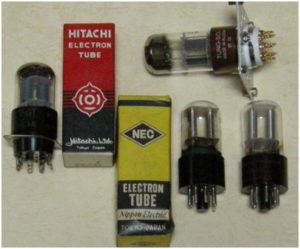
Moreover, the sound of 6 SL 7 of NATIONAL Electronics, NEC’s nickel plate is also difficult to throw away.
6 SL 7 Vacuum tube of each manufacturer. Two of the boxes behind the NEC box are nickel plate 6 SL 7
2A3 has RCA Original, but recently it got less clear at shop front, but it is still available on internet.
Most of the ones on the market are made in China, made in Russia.
In this machine, RCA’s single plate and two plate are over plate specifications but can be used if the voltage is lowered.
This time I use 2A3 of EH thought that I can drive with leeway.
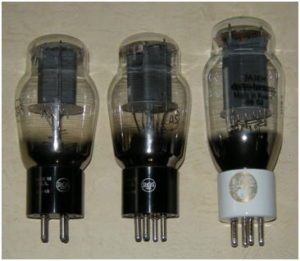
A lot of 833 A recently made in China are on the market, making it easy to obtain.
When I was seeking, I think that it was only known to some people who are almost mania.
It seems that most of these applications were as a final stage at radio frequency (RF)
In the RCA manual, as an example of use in AF (audio band) together with motion data at this frequency,
An example of use as an AF modulator is listed.
I tried out the specification of the output tube 833 A from the RCA data sheet below.
Main application: frequency band up to RF (Radio Frequency) band (30 MHz)
And natural modular air cooling or forced air cooling direct heat triode that can be used in the audio modulator output stage.
Maximum rating (ICAS standard)
Heater voltage: 10 V, current: 10 A
DC Anode Voltage: 3300 V
MAX Signal DC Anode Current: 500 mA
MAX Signal Anode Input: 1300 W
Anode Dissipation: 350 W
Operation example (at radio frequency)
DC Anode Voltage: 3300 V
DC Grid Voltage: -100 V
Peak RF Grid Voltage: 110 V
DC Anode Current: 150 mA
Driving Power: 11 W
Power Output: 200 W
With the above data, the anode voltage of 3.300 V is not common to our amateur,
If such a high voltage is applied, it seems that even if the grid bias voltage is about -100 V, the anode current flows about 150 mA.
In this use, a current of about 1.000 V and a current of about 80 mA flows at 0 V bias,
Use a slight positive bias on the grid and use an anode current from 150 mA to 250 mA.
Unfortunately, this “Tiger ‘s child”, which only one of these was recently unavailable, has been inadvertently damaged.
It was an event in replacing the amplifier.
Unavoidably, the one used for this machine was made in China, purchased with porcelain socket, plate and grid cap.
(Even so, it is the first time for a thick glass tube, so I looked at the broken section in a row.
I have trouble mounting this pipe.
Support one side with a plate and two grids, and support the other side with two electrodes of a heater,
It seems to be common to use the vacuum tube main body exposed to the air and forced air cooling with natural air cooling or a fan, so it can be seen on overseas HP.
With a socket, this machine has a structure that stops at a porcelain socket with two electrode heater of a heater.
However, as it is impossible to attach to a metallic chassis as it is, we made our own adapter with a glass epoxy board thickness of 5 mm.
This adapter is assumed to be used with the socket attached to the vacuum tube, as indicated in the first picture of the previous one.
Of course it is possible to use just this sintered porcelain socket, but considering forcibly air-cooling with a fan from the bottom of this machine,
Screw the adapter screw to the chassis via a spacer (about 60 mm). See size image of this adapter.
As mentioned above, this machine is composed of only three vacuum tubes of one CH,
Voltage and current handled are also high voltage / high current, output is not too ordinary.
We must pay close attention to the parts to be used, mounting and assembly.
833A socket adapter. Square with 160 mm side. The material is a glass epoxy board with a thickness of 5 mm.
From the center to the porcelain socket, hollow out to a circular shape of 72 mm in diameter. With 5.5 mm or 6.0 mm screw
Attach to porcelain socket and chassis.
The following images were actually produced.
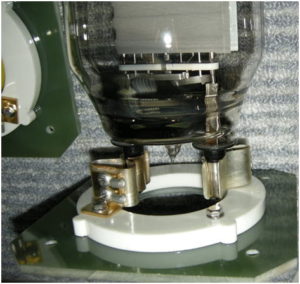
A state in which the vacuum tube 833 A is fitted in the socket and the adapter.
Also, as shown in the figure below, mount on the chassis to hang the adapter with a 60 mm metal spacer.
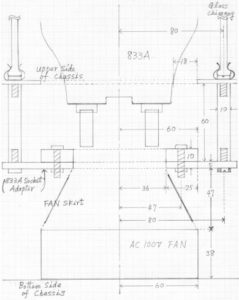
Up to here for this time ··············.
第四
2011.06.29起來
1. 833單個放大器Ⅱ使用部件(1)真空管
其他……一開始解釋目的地一次
2A3(C)偏置電阻R7和驅動變壓器次級進入和具有電阻R3,R4大約。
R 7是一個重要的偏置電阻器,用於確定2A3(C)的操作點大家知道,應被設置為的2A3(C)中的最佳工作點。
相比之下R3,R4是2A3(C)總是具有通過在最佳運行點運行輸出的動力,
因為它可能不是833A的最佳輸入電壓,它的目的是調整兩個電阻器。
在許多情況下,這個階段往往會過驅動,833A的驅動適當的電源,
如何調整的2A3(C)中的R 7是一般般,但這裡是由R3,R4調整。
**********到目前為止的補充說明***********
關於真空管6SL7,2A3(C),833A以及插座和適配器
第一級真空管6SL7想務必使用RCA的可靠管5691。
因為它是尚未公佈,但暫時是TUNSOL,日本日立製作,裡面還有NEC的事情。
也是國家電子,也很難扔掉鎳板的NEC的6SL7聲音。
6 SL 7各製造商的真空管。 NEC盒子後面的兩個盒子是鎳板6 SL 7
2A3是RCA原來是這樣,最近已顯著少成為過度的櫃檯,也可在互聯網上呢。
市場上大多數產品都是在中國生產,在俄羅斯生產。
在該機器中,由RCA,一個板,兩個板之一製造是板標準以上,就可以通過降低電壓來使用。
這一次,使用EH的,這似乎是能夠驅動剩餘空間的2A3。
最近在中國生產的833 A很多都在市場上,很容易獲得。
由你真正被問的時候,我覺得還沒有只知道誰是說是幾乎癲狂的人的一部分。
似乎大多數這些應用都是射頻(RF)的最後階段
RCA的手冊用在此頻率為AF使用的示例的操作數據一起(音頻帶),
列出了用作AF調製器的示例。
我從下面的RCA數據表中試用了輸出管833 A的規格。
主要應用:頻帶高達RF(射頻)頻段(30 MHz)
自然冷卻或強制冷卻空氣直接加熱三極管可直接或音頻調製器輸出級。
最高等級(ICAS標準)
加熱器電壓:10 V,電流:10 A.
直流陽極電壓:3300 V.
MAX信號直流陽極電流:500 mA
MAX信號陽極輸入:1300 W
陽極耗散:350 W
操作示例(射頻)
直流陽極電壓:3300 V.
直流電網電壓:-100 V.
峰值RF電網電壓:110 V.
直流陽極電流:150 mA
驅動功率:11 W
功率輸出:200 W
另外,在上述的數據,但陽極電壓3.300V是我們不常見於業餘,
加入這麼多的高電壓,柵極偏置電壓-100V,即使位置中的,陽極電流流150毫安位置。
在1.000V比當前使用更少一點的電壓,因為在0V左右時偏壓80毫安的電流流動時,
在電網上使用輕微的正偏壓,並使用150 mA至250 mA的陽極電流。
不幸的是,只在最近這一次也得到了無意中損壞沒有這個“孩子的老虎”可用。
這是更換放大器的一個事件。
勉強那些所使用的單元的是中國製造,購買瓷插座,板,用柵網蓋。
(即便如此,所以厚的玻璃真空管進行備受關注首次它是。損壞的橫截面。)
我無法安裝此管道。
板,支撐一個由兩個網格,那麼其他支持的加熱器的兩個電極,
如何使用通過自然空氣冷卻或風扇暴露真空管體中空部分的一般方式的強制空氣冷卻,它可以在HP中找到海外。
隨著在手機的插座是停止瓷插座加熱器兩個電極腿的結構。
然而,由於在這種狀態下就不能附著於金屬底盤,並擁有與玻璃環氧板厚度為5mm的適配器。
此適配器是用於在安裝在真空管插座,示為前面的第一圖像中的狀態使用。
當然,但它可用於該狀態的單獨瓷插座,從機器的底部殼體的強制空氣冷卻風扇的思維,
通過墊片(約60 mm)將適配器螺釘擰到機箱上。請參閱此適配器的大小圖像。
雖然機器是由管件CH如上所述只有三個構成
處理的電壓和電流也是高電壓/高電流,輸出不是太普通。
我們必須密切關注要使用的部件,安裝和裝配。
833A插座適配器。正方形,160毫米邊。該材料是玻璃環氧樹脂板,厚度為5毫米。
從中心到匹配瓷插座,挖空圓直徑72毫米。使用5.5 mm或6.0 mm螺釘
連接瓷插座和底盤。
實際生成了以下圖像。
如何安裝真空管833A到插座和適配器。
此外,實施機箱在下面的圖中所示,以允許暫停使用的金屬墊片60毫米適配器。
這個時間直到這一點……….
5th
2011.07.12 up
4. 833A single amplifier Ⅱ use parts (2) Transformers, coupling capacitors, etc.
Consider output transformer, driver / transformer, grid CH, other coupling capacitor, over / all feedback capacitor.
In this class of amplifiers, it becomes difficult to obtain all transformers from commercial products.
I thought about things that are currently available at the Internet,
It is inevitable that it will be a custom item specification to finally upgrade.
Looking at the flow of the signal, the input AF signal enters the SRPP circuit of the first stage amplification 6 SL 7, is amplified, low impedance converted,
Drive the power drive tubes 2A3 / 300B via coupling capacitors.
The problem here is the coupling capacitor Cc and the grid / choke GH that is juxtaposed with the grid of the driver pipe.
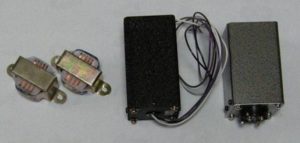
Various grid · choke · transformer.
Left side: 650 H less than 1 mA. This can be used as an alternative to the input resistance of the first stage 6SL7. The low frequency characteristic is greatly improved.
Center: 2A3 / 300B grid · choke satisfying this specification FMEC 600 H 600 H / DC 8 mA
Right side: Tango TC – 160 – 15 W 160 H / DC 15 mA, 40 H / DC 30 mA For small current power pipe
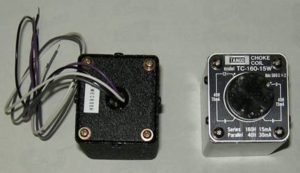
Two kinds of grid · choke decided to end to the last. After all it is decided to Noguchi · finemet FMEC 600 H of black cover on the left side.
A coupling capacitor Cc of about 1 μF, a high quality film capacitor with 250 V withstand voltage (Mundorf, solen film condenser) etc.
I want to use, but an oil condenser of about 10 microns is also suitable.
In this case, use SHIZUKI’s 30 μF oil con. In addition, GH uses Noguchi Fine Met FMEC-600H.

Cc coupling capacitor SHIZUKI 30 μF 220 VAC
In order to eliminate even a slight phase rotation as the audio signal passes through it,
Taking a very large time constant to the extent that the high range characteristic is not sacrificed
(When looking at the frequency, if the phase rotation is more than 10 degrees, the frequency characteristic begins to drop off slowly).
Since the grid current flowing through this choke hardly causes a problem, small CH is often used,
In order to avoid ion current, it is desirable that the DCR is as small as possible.
For that purpose, the impedance including the coupling capacitor should be lower.
The signal power-amplified by 2A3 / 300B drives the driver / transformer.
This driver / transformer uses HD-24 of hat audio hatt_au.
It is difficult to understand in the wiring diagram, but it is a Shishido type intra reversing transformer drive that reverses the winding start and winding end of the transformer.
However, the current capacity of the primary winding of this transformer should be 60 mA or more.
Transformer of silver silver hammer tone on the left is driver / transformer HD – 24.
A grid current (maximum of about 50 mA) of 833 A flows on the secondary side of the transformer,
This current reverses and flows so as to cancel the primary current.
The cold side of this winding coil is grounded at zero bias but plus voltage is applied at plus bias,
The bypass capacitor at this point is also a part of the signal flow path. Also note this point and select the bypass capacitor.
A word about over-all NF’s phase correction capacitor.
Although it is specified as 200 pF in the circuit diagram, care is taken with regard to the selection of this capacitor.
Mica, styrene, film, etc. are suitable, but it is better not to use ceramic condenser even if it is wrong.
Here we use old caramel type mica capacitors.
(Although I had received a request for repair of a tube amplifier of a famous manufacturer,
At this time, I have experienced the fact that the ceramic capacitor of this feedback circuit has caused the sound quality deterioration of the whole amplifier.
Ceramic capacitors have large dielectric losses and large dielectric constants, so I think that it is appropriate to use them in the high frequency range above RF. )
At the present stage, the output transformer OUT of the power amplification stage 833 A uses HO-833 N of hatt_au.
This transformer has a very large core size, and it is larger than the largest of tango trance.
In addition, since the winding diameter is also large, a current of 150 mA or more can also flow.
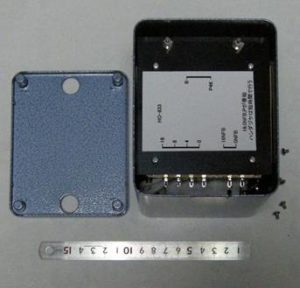
Hatt_au Hat Audio HO-833N Output Transformer
This output transformer is scheduled to change to one using finmetmet’s 1 KVA core in the end, but it is not yet available.
What is required for this transformer is that when an anode current of about 150 mA (preferably 250 mA) flows through 833 A,
I would like to have core / volume that can not easily be DC magnetized, KNF windings, and possibly over-all NF windings.
In the case of a single transformer, there seems to be a problem of direct current magnetization, and it seems that it is rather difficult to manufacture.
At the moment OUT which satisfies such a demand is not commercially available, so we are in discussion with a transformer maker.
第五名
2011.07.12起
4。 833A單放大器Ⅱ使用部件(2)變壓器,耦合電容器等
考慮輸出變壓器,驅動器/變壓器,電網CH,其他耦合電容,過/全反饋電容。
在這類放大器中,很難從商業產品中獲得所有變壓器。
我想到了互聯網上目前可用的東西,
最終升級是不可避免的自定義項目規範。
觀察信號的流動,輸入的AF信號進入第一級放大器6 SL 7的SRPP電路,被放大,低阻抗轉換,
通過耦合電容驅動功率驅動管2A3 / 300B。
這裡的問題是耦合電容器Cc和與驅動管的柵格並置的柵極/扼流圈GH。
各種電網·扼流圈·變壓器。
左側:650 H小於1 mA。這可以用作第一級6SL7的輸入電阻的替代。低頻特性大大提高。
中心:2A3 / 300B電網·扼流圈符合此規範FMEC 600 H 600 H / DC 8 mA
右側:Tango TC – 160 – 15 W 160 H / DC 15 mA,40 H / DC 30 mA用於小電流電源管
兩種網格·扼流圈決定結束到最後。畢竟它決定了左側的Noguchi·finemet FMEC 600 H的黑色封面。
一個約1μF的耦合電容Cc,一個具有250 V耐壓的高質量薄膜電容器(Mundorf,螺線管薄膜電容器)等。
我想使用,但約10微米的油冷凝器也是合適的。
在這種情況下,使用SHIZUKI的30μF油。此外,GH使用Noguchi Fine Met FMEC-600H。
Cc耦合電容SHIZUKI30μF220VAC
為了在音頻信號通過時消除輕微的相位旋轉,
採用非常大的時間常數達到不犧牲高範圍特性的程度
(當查看頻率時,如果相位旋轉超過10度,則頻率特性開始緩慢下降)。
由於流過該扼流圈的柵極電流幾乎不會引起問題,因此經常使用小的CH,
為了避免離子電流,期望DCR盡可能小。
為此,包括耦合電容器的阻抗應該更低。
由2A3 / 300B功率放大的信號驅動驅動器/變壓器。
這個驅動器/變壓器使用帽子音頻hatt_au的HD-24。
在接線圖中很難理解,但它是一個Shishido型內部反向變壓器驅動器,它可以反轉變壓器的繞組啟動和繞組端。
但是,該變壓器初級繞組的電流容量應為60 mA或更高。
左側的銀色銀錘音變壓器是驅動器/變壓器HD – 24。
833 A的電網電流(最大約50 mA)流過變壓器的次級側,
該電流反轉並流動以消除初級電流。
該繞組線圈的冷端在零偏壓下接地,但在正偏壓下施加正電壓,
此時的旁路電容也是信號流路徑的一部分。另請注意這一點並選擇旁路電容。
關於整體NF的相位校正電容器的一個詞。
雖然在電路圖中規定為200 pF,但要注意選擇該電容。
雲母,苯乙烯,薄膜等是合適的,但即使錯誤也最好不要使用陶瓷冷凝器。
這裡我們使用舊的焦糖型雲母電容器。
(雖然我收到了一家著名製造商的電子管放大器維修請求,
這時,我經歷了這個反饋電路的陶瓷電容導致整個放大器的音質惡化的事實。
陶瓷電容器具有大的介電損耗和大的介電常數,因此我認為在RF以上的高頻範圍內使用它們是合適的。 )
在現階段,功率放大級833A的輸出變壓器OUT使用hatt_au的HO-833N。
這種變壓器具有非常大的磁芯尺寸,並且比探頭恍惚的最大尺寸大。
另外,由於繞組直徑也大,所以也可以流過150mA或更大的電流。
Hatt_au Hat Audio HO-833N輸出變壓器
該輸出變壓器計劃在最後使用finmetmet的1 KVA內核更改為1,但尚未提供。
這種變壓器需要的是當大約150 mA(最好是250 mA)的陽極電流流過833 A時,
我希望核心/體積不易被直流磁化,KNF繞組,甚至可能是整個NF繞組。
在單個變壓器的情況下,似乎存在直流磁化的問題,並且似乎製造起來相當困難。
目前滿足這種需求的OUT尚未商業化,因此我們正在與變壓器製造商進行討論。
Sixth
2011.07.21 up
5. Output transformer and vacuum tube 833 A chimney
The large OUT arrived. The output transformer I had been planning for some time has become genuine.
W: 180 × D: 180 × H: 230 mm Weight Approximately 20 Kg with oil. It is the first time to handle such a big transformer.
It is one tube amp that is equal to this one transformer.
The specifications of the transformer are designed as 833 A anode current 250 mA, impedance 3 KΩ, primary safety current 400 mA.
Also with KNF, over all NF windings.
A glass chimney has also been completed. I have asked you from the past to the glass workshop in the neighborhood.
The material was Pyrex 5 mm thick, we got tapered for attachment to the bottom. The size is 160 mm in diameter and 140 mm in height.
Opaque glass treated on outer surface.
I got it very carefully made, so when I ignited the heater of 833 A, it looks very beautiful from the outside.
I tried to arrange these again on a flat plate.
High voltage power transformer, low voltage power transformer, high pressure smooth oil and film condenser, low pressure smooth oil condenser are arranged on the chassis.
The remaining units and parts are stored in the sub chassis inside the chassis.
For this reason, the interior of the chassis has a two-storied structure and a structure that considers later maintenanceability is adopted. The depth of the chassis is scheduled to be 150 mm.
Just arranging, it’s cluttered! Feeling a bit odd.
I need to devise a chassis layout. I compared the approximate size of each part.
The inside of the chassis has a two-storied structure
第6
2011.07.21起來
5。輸出變壓器和真空管833煙囪
大OUT到了。我一直計劃的輸出變壓器已經變得真實了。
W:180×D:180×H:230mm重量約20Kg油。這是第一次處理這麼大的變壓器。
它是一個電子管放大器,等於這一個變壓器。
變壓器的規格設計為833 A陽極電流250 mA,阻抗3KΩ,初級安全電流400 mA。
還有KNF,所有NF繞組。
玻璃煙囪也已完工。我曾經問你過去附近的玻璃工作室。
材料是Pyrex 5毫米厚,我們得到錐形連接到底部。尺寸為直徑160毫米,高140毫米。
外表面處理不透明玻璃。
我非常仔細地製作它,所以當我點燃833 A的加熱器時,它從外面看起來很漂亮。
我試著在平板上再次安排這些。
底盤上設有高壓電力變壓器,低壓電力變壓器,高壓光滑油膜冷凝器,低壓光滑油冷凝器。
其餘的單元和部件存儲在機箱內的子機箱中。
因此,底盤的內部具有兩層結構,並且採用考慮以後的可維護性的結構。機箱的深度預定為150毫米。
只是安排,它是雜亂的!感覺有點奇怪。
我需要設計一個底盤佈局。我比較了每個部分的大致尺寸。
底盤內部採用兩層結構
The 7th
2011.07.25 up
6. Power supply circuit (all circuits)
The power supply section of this amplifier is shown below.
Although it is the electric power supplied to the vacuum tube of only three amplification parts, it is very big as a power supply.
Just arranging the parts of this power supply part, it occupied 2/3 of the area of the whole amplifier.
High voltage power supply (about 980 V maximum 250 mA):
Bridge rectify 380 V × 2 300 mA to obtain about 980 V. Use Si – Diode used for 2 series of acoustic for Toshiba of 1.5 KV 3A.
Next, it enters the AF smoothing circuit via RF Choke Coil (about 10 mH) and film con (0.22 μF) as RF Filter.
Smoothing condenser:
Electric field (Chemicon) condenser is generally used, but considering aged deterioration, high temperature, high pressure environment,
I am concerned about the use as the main filter capacitor.
Here, the oil con is used for the first row, and the film con is used for the second and third rows. Capacity shortage at these stages is supplemented with electric field condenser block.
However, the chemicons to be used are arranged and blocked so as to facilitate exchange later, and this block is exchanged.
833 A Heater:
The heater of the output tube 833A is 10 V 10 A and it is such a serious rice dish.
Although it is common in the transmission tube of this class, it plagues the timing of use with the audio amplifier.
The HP-833 transformer of hatt_au is simple, as it has a dedicated 833 A heater winding.
The rectifying diode is a Shottoky Type, and one having a capacity of 30 A or more is selected.
833 A Grid Bias regulator:
It can be used as long as it can be varied in the range of 2 to 15 V with DC capacity of 0.1 A capacity. Here we made it easily using LM317T.
Low voltage power supply (400 V 100 mA):
6SL7, 2A3C (300B). Use rectifier tube 5AR4. It consists of two stages of LC Filter.
Here too, an oil condenser is used as a filter condenser.
2A3C, 300B Heater:
Hatt_au Supplied from each dedicated winding terminal of HP-2A 300 transformer. 2A3C 2.5V 2.5A AC ignition intact.
300B is rectified by Shottoky Bridge Diode, it is slightly luxurious, but it is supplied through Sanken’s 5 terminal Regulator STR 900 (5 V 4 A).
Bridge and Regulator used here … Since the voltage from the transformer is low at 6.3 V AC,
In an ordinary three-terminal regulator, the rectified voltage is too low and there is concern about the constant voltage operation.
Therefore, STR 9005 (1 V) with small input-output voltage difference is used, and the rectifying diode also uses Shottoky Bridge.
Main parts
① High voltage (833 A anode voltage) power supply circuit, smoothing condenser, power supply smoothing CH, etc.
Power transformer: hatt_au HP833 AC 380 V x 2 760 V 300 mA, 9 V 4.5 A x 4, 20, 40 V 0.1 A
AF Choke Coil: 5 H 300 mA × 2
RF Choke Coil: 10 mH 1.5 A × 2 (with core)
Smoothing capacitor: 1st OIL 100 μF 650 V + 100 μF 650 V = 50 μF Used as 1. 300 V
2nd FILM 47μF 1.200V
3 rd FILM 47 μF 1.200 V
4th Chemicon 470 μF 450 V × 3 150 μF Used as 1.350 V
② Low-voltage power supply circuit, smoothing condenser, power smoothing CH, etc.
Power transformer: hatt_au HP2A300 350-300-0-300-350V 0.16A, 0-2.5-6.3V 2.5A x 2, 5V 3A, 6.3V 2A
AF Choke Coil: 10 H 140 mA × 2
Smoothing capacitor: 1st OIL 50μF 650V
2nd OIL 50μF 650V
3 rd OIL 50 μF 650 V
第7個
2011.07.25起來
6。電源電路(所有電路)
該放大器的電源部分如下所示。
雖然僅為三個放大部件提供給真空管的電力,但它作為電源非常大。
只需安排該電源部分,它就佔據了整個放大器面積的2/3。
高壓電源(約980 V最大250 mA):
橋式整流380 V×2 300 mA,獲得約980 V.使用Si – 二極管用於1.5KV 3A的東芝的2系列聲學。
接下來,它通過RF扼流線圈(約10 mH)和膜con(0.22μF)作為RF濾波器進入AF平滑電路。
平滑冷凝器:
通常使用電場(Chemicon)冷凝器,但考慮到老化,高溫,高壓環境,
我擔心用作主濾波電容器。
這裡,油錐用於第一排,膜con用於第二排和第三排。這些階段的容量不足補充了電場冷凝器塊。
然而,要使用的化學物質被排列和封閉以便於以後更換,並且更換該塊。
833 A加熱器:
輸出管833A的加熱器是10V 10A,並且它是如此嚴重的米飯盤。
雖然這種類型的傳輸管很常見,但它會影響音頻放大器的使用時間。
hatt_au的HP-833變壓器很簡單,因為它有一個專用的833 A加熱器繞組。
整流二極管是Shottoky型,選擇容量為30A或更大的二極管。
833 A Grid Bias監管機構:
它可以使用,只要它可以在2到15 V的範圍內變化,DC容量為0.1 A容量。在這裡,我們使用LM317T輕鬆完成。
低壓電源(400 V 100 mA):
6SL7,2A3C(300B)。使用整流管5AR4。它由兩個階段的LC濾波器組成。
在這裡,也使用油冷凝器作為過濾冷凝器。
2A3C,300B加熱器:
Hatt_au從HP-2A 300變壓器的每個專用繞組端子提供。 2A3C 2.5V 2.5A AC點火完好。
300B是由Shottoky橋式二極管整流後的土地,但有點奢侈,通過終端5的三肯穩壓STR9005(5V 4A)進料。
此處使用的電橋和穩壓器……由於變壓器的電壓低至6.3 V AC,
在普通的三端穩壓器中,整流電壓太低,並且擔心恆壓操作。
因此,使用具有小輸入輸出電壓差的STR 9005(1 V),並且整流二極管也使用Shottoky Bridge。
主要部件
①高壓(833 A陽極電壓)電源電路,平滑電容器,電源平滑CH等
電源變壓器:hatt_au HP833 AC 380 V x 2 760 V 300 mA,9 V 4.5 A x 4,20,40 V 0.1 A
AF扼流圈:5 H 300 mA×2
射頻扼流圈:10 mH 1.5 A×2(帶芯)
平滑電容器:第一個OIL100μF650V +100μF650V =50μF用作1. 300 V
第二層FILM47μF1.200V
第3層FILM47μF1.200V
第4 Chemicon470μF450V×3150μF用作1.350 V.
②低壓電源電路,平滑電容器,電源平滑CH等
電力變壓器:hatt_au HP2A300 350-300-0-300-350V 0.16A,2.5A 0-2.5-6.3V×2,5V 3A,6.3V 2A
AF扼流圈:10 H 140 mA×2
平滑電容器:第一個OIL50μF650V
第二油50μF650V
3 rd OIL50μF650V.
The 8th
2011.07.31 up
7. Assembling the power supply unit (1)
A sub-chassis is provided in the chassis, and a circuit on the right half of the Terminal Board shown in the figure below is prepared and arranged on this chassis.
High and low voltage power supplies are concentrated on this Terminal Board board and distributed from this board to each circuit. (Considering the maintenance afterwards.)
(2 low pressure circuit choke (10H 140 mA) of the circuit on the right from Terminal Post, Chemi-Con Block, HV Rectifier Board,
Built on sub-chassis together with this terminal board.
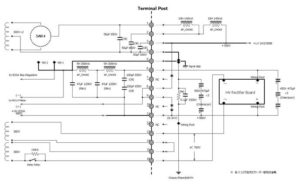
The wiring of each power transformer, high pressure choke, oil, film con, etc. of the left side circuit is assembled on the main body chassis. )
In circuit assembly, Signal GND is not directly Chassis Earth,
It gathers at one point on the Terminal Post and becomes Chassis Earth via 1 MΩ. In case
Terminal Board to concentrate power supply circuit
High voltage power supply board (high voltage power supply rectifier circuit and smooth chemistry block, HV Rectifier Board and Filtering Capacitor)
Each of the chemicons used for high-voltage power supply smoothing is highly deteriorated due to the environment at high temperature and high pressure.
In consideration of the subsequent maintenance, replace this block by blocking it for ease of exchange.
Another Chemicon block (470 μF 450 V 3 blocks in series, 150 μF 1.350 V per block).
Fix to a commercially available standard type glass epoxy substrate with epoxy adhesive.
Both are connected in parallel with the main high pressure oil condenser (100 μF – 100 μF 1.300 V) and the film condenser (47 μF 1.200 V).
(When using Chemicon, Oilcon in series, to raise the overall applied voltage withstand voltage,
Connect a bleeder resistor of 100 KΩ or more in parallel with each capacitor so that the voltage is evenly applied to each capacitor. )
470 μF 450 V 3 blocks in series 1 block 150 μF 1.350 V
第8天
2011.07.31起來
7。組裝電源裝置(1)
機箱中提供了一個子機箱,下圖所示的終端板右半部分的電路準備並安排在該機箱上。
高壓和低壓電源集中在該端子板上,並從該板分配到每個電路。 (考慮到之後的維護。)
(2個低壓電路扼流圈(10H 140 mA)的電路位於Terminal Post,Chemi-Con Block,HV整流器板的右側,
與此端子板一起構建在子機箱上,
左側電路的每個電力變壓器,高壓扼流圈,油,薄膜等的佈線組裝在主體底盤上。 )
在電路組裝中,信號GND不是直接底盤地球,
它聚集在Terminal Post上的一個點上,並通過1MΩ變為Chassis Earth。如果
端子板集中供電電路
高壓電源板(高壓電源整流電路和光滑化學塊,高壓整流板和濾波電容器)
用於高壓電源平滑的每個化學元件由於高溫和高壓環境而嚴重劣化。
考慮到後續維護,請更換此塊以便於更換。
另一個Chemicon塊(串聯470μF450V 3塊,每塊150μF1.350V)。
用環氧粘合劑固定到市售的標準型玻璃環氧基材上。
兩者均與主高壓油冷凝器(100μF – 100μF1.300V)和薄膜冷凝器(47μF1.200V)並聯。
(當使用Chemicon,Oilcon串聯時,提高整體施加的耐壓,
每個電容器並聯一個100KΩ或更高的洩放電阻,使電壓均勻地施加在每個電容上。 )
串聯1個模塊中的470μF450V 3模塊150μF1.350V
The 9th
2011.08.08 up
8. Assembling the power supply unit (2)
833A heater power supply rectifier circuit and smooth chemi-block block, 833A bias voltage regulator and 300B heater constant voltage power supply circuit
The heater of the output pipe 833 A is full-wave rectified by Schottky Diode and the heater of the drive pipe 300 B is rectified by Schottky Diode Bridge,
Through the smoothing circuit of the Chemicon block.
Large block is 833 A heater rectifier circuit Smoothing capacitor · block 50 V 6.800 μF × 6.
Capacitor block for small block 300B heater 35V 6.800 μF × 3.
833 A Heater DC rectification and smoothing (transformer · tap 9 V 4.5 A × 4 as full wave rectification)
Circuit of 833A Bias Regulator
833A Bias regulator Board (2 to 15 V 0.1 A), S.B diode Bridge (60 V 15 A), Twin S.B Diode (45 V 30 A) and STR 9005 (5 V 4 A) AVR IC
The heater of 833 A uses Schottky Diode, which has a small internal voltage drop in the element, a small power loss and a small calorific value.
Use a Schottky Diode with a small internal voltage drop so that the rectified voltage from the transformer / tap is as low as 9 V and both waves are rectified to 10 V.
For 300 B also, S. B diode Bridge is used for the same reason.
Combine the 300 B Heater DC circuit as shown in the dotted frame. Even here, if you set up Terminal Post, later maintenance will be easier.
(Note) Although not an overall circuit diagram, after Schottky Bridge rectification, insert RFF of 0.1 μF and 200 μH.
第9次
2011.08.08起來
8。組裝電源裝置(2)
833A加熱器電源整流電路和光滑化學塊,833A偏壓調節器和300B加熱器恆壓電源電路
輸出管833A的加熱器由肖特基二極管全波整流,驅動管300B的加熱器由肖特基二極管橋整流,
通過Chemicon塊的平滑電路。
大塊是833 A加熱器整流電路平滑電容器·塊50 V6.800μF×6。
用於小型塊300B加熱器的電容器塊35V6.800μF×3。
833 A加熱器直流整流和平滑(變壓器·抽頭9 V 4.5 A×4作為全波整流)
833A偏置調節器電路
833A偏置調節器板(2至15 V 0.1 A),S.B二極管橋(60 V 15 A),雙S.B二極管(45 V 30 A)和STR 9005(5 V 4 A)AVR IC
833 A的加熱器採用肖特基二極管,元件內部電壓降小,功率損耗小,發熱量小。
使用內部壓降較小的肖特基二極管,使變壓器/分接頭的整流電壓低至9 V,並將兩個波整流至10 V.
對於300 B,同樣使用S. B二極管橋。
將300 B加熱器直流電路組合在一起,如虛線框所示。即使在這裡,如果您設置了Terminal Post,以後的維護也會更容易。
(注)雖然不是整體電路圖,但在肖特基橋整流後,插入0.1μF和200μH的RFF。
10th
2011.09.27 up
9. Review of 833A Heater circuit and lighting experiment by SW Regulator
One of the difficult parts of this amplifier is a heater power supply circuit of the output tube 833A.
Although it was originally an uneasy design, Simple is the best! So I decided on this.
It was planned to obtain 10 V 10 A after passing through the smoothing circuit after rectification with full wave rectification of DC 9 V 4.5 A × 4,
Rectifier malfunctions during experiments, then many ripples can not be used, the voltage after rectification is low, it is not stable etc.
Overall we decided to review the Heater power circuit and rectifier circuit.
Then, in order to stably supply the heater power of DC 10 V 10 A
I found that a solid transformer and rectification / smoothing circuit are necessary.
In this time, we went off the previous method and thought about supplying heater power by switching regulator.
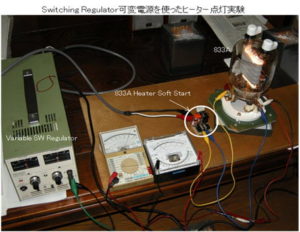
When using a commercially available switching regulator,
Since regulation of 10 V or 12 V (SW regulator used this time is 12 V 14 A output ± 10% variable type) is good,
Rush Current immediately after SW ON is very large.
As a result, a heavy stress is applied to the 833 A heater, which makes it difficult to shorten the life of the vacuum tube.
In order to prevent this, insert a Soft Start circuit so that the heater voltage rises slowly.
This time I tried a very simple circuit using a MOSFET, but I confirmed that it works well.
The 10 V 10 A power output from the SW Regulator circuit enters toroidal choke of 1 mH 10 A to reduce noise,
Next, it enters the Soft Start circuit using MOSFET and is output.
Since the MOSFET is turned off immediately after SW ON,
The circuit is in a state where R of 0.5 Ω 5 W is inserted in series,
A large voltage drop occurs with this resistor, so much power is not applied to the 833A.
After a while (after about 0.5 Sec) short this resistor with FET. Thereafter, a current of 10 A flows through the FET,
This voltage drop should be much less than the external 0.5 Ω voltage drop
For the MOSFET to be used, the insertion loss is small and the heat generation amount is minimized,
Select very small ON resistance (several tens of mΩ or less).
For fabrication, we placed a MOSFET with a radiator on one small PC board,
Place the toroidal choke on it, fix each radiator and coil to this board with epoxy adhesive,
Based on this, it gathers in the aerial wiring. For mounting, this board is screwed to the case via a spacer.
Since a large current of 10 A flows in the steady state in this circuit,
It is a simple circuit, but be careful enough to make sure that you do not have trouble.
In addition, Heater of 833 A uses the SW regulator experimented this time,
The transformer taps, rectifiers, and the larger chemi-con block that we introduced earlier are no longer necessary.
The SW Regulator Unit (12 V 14 A) actually incorporated in the amplifier, the Silicon Bridge, the Soft Start Unit
十號
2011.09.27起來
9.通過SW調節器審查833A加熱器迴路和照明實驗
該放大器的一個難點是輸出管833A的加熱器電源電路。
雖然它本來是一個不安的設計,但Simple是最好的!所以我決定這個。
計劃在DC 9 V 4.5 A×4全波整流整流後通過平滑電路後獲得10 V 10 A,
整流器在實驗過程中出現故障,則不能使用很多波紋,整流後電壓低,不穩定等。
總的來說,我們決定審查加熱器電源電路和整流器電路。
然後,為了穩定地提供DC 10 V 10 A的加熱器功率
我發現需要一個堅固的變壓器和整流/平滑電路。
在這個時候,我們採用了以前的方法,並考慮通過開關穩壓器提供加熱器功率。
使用市售的開關穩壓器時,
由於10 V或12 V的調節(這次使用的SW調節器是12 V 14 A輸出±10%可變型)是好的,
SW ON後立即衝擊電流非常大。
結果,對833A加熱器施加了很大的應力,這使得難以縮短真空管的壽命。
為防止這種情況,請插入軟啟動電路,使加熱器電壓緩慢上升。
這次我嘗試使用MOSFET的非常簡單的電路,但我確認它運行良好。
SW穩壓器電路的10 V 10 A功率輸出進入1 mH 10 A的環形扼流圈,以降低噪聲,
接下來,它使用MOSFET進入軟啟動電路並輸出。
由於MOSFET在SW ON後立即關閉,
電路處於串聯插入R為0.5Ω5W的狀態,
該電阻會產生很大的壓降,因此833A不會產生太大的功率。
過了一會兒(大約0.5秒後)用FET短接這個電阻。此後,10 A的電流流過FET,
該電壓降應遠小於外部0.5Ω電壓降
對於使用的MOSFET,插入損耗小,發熱量最小化,
選擇非常小的導通電阻(幾十mΩ或更小)。
為了製造,我們在一塊小型PC板上放置了帶散熱器的MOSFET,
將環形扼流圈放在上面,用環氧粘合劑將每個散熱器和線圈固定到該板上,
基於此,它聚集在架空線路中。為了安裝,該板通過墊片擰到殼體上。
由於10 A的大電流在此電路中處於穩定狀態,
這是一個簡單的電路,但要小心,以確保你沒有麻煩。
此外,833 A的加熱器使用SW調節器這次實驗,
不再需要我們之前介紹的變壓器分接頭,整流器和更大的chemi-con模塊。
SW穩壓器單元(12 V 14 A)實際上包含在放大器,矽橋,軟啟動單元中
Eleventh
2011.10. 30 up
10. Lighting experiment using SW Regulator of 833A Heater (2)
In the previous experiment, using the experimental constant voltage power supply device at the beginning,
Next, I was able to grasp the state of the Heater ignition for a while in a preliminary experiment using the SW Regulator Unit (12 V 14 A)
It turned out that there was a problem with the following points.
By turning on the filament of 833A, the power supply unit (several models including made in China)
Although all of the output 10 V 10 A standard is satisfied,
Considering the use for a long time, I found that SW Regulator Unit (12 V 14 A), which I could prepare at this time, also feels uneasy.
Continuous operation for about 15 minutes will cause the radiator to generate heat to the extent that it does not touch the hand.
I decided that it is impossible to use without a fan in long driving.
As an alternative,
Recently I was able to get one made by TAMURA Electric Co., Ltd. of Japan with more standards (12 V 30 A) than the previous one at Yahoo auction.
As a result of early experiments, there is no need for a fan, and the radiator is slightly warming even for continuous 30 minutes of operation.
Again, in order to supply power of 10 V 10 A steadily for a long time, the power supply of this capacity is necessary.
Because this unit has a fuse on the AC input side for safety,
Although the outline is large, you can safely install it in the amplifier.
Next, the problem about Bridge Diode.
Bridge Diode is based on 50 A standard, but if DC 10 A is thrown into a Diode of a piece of Bridge
It heats up to the extent that it can not be touched with ten seconds.
So here we use 2 50 A Bridge and 4 D iode in para.
In AC rectification and DC, I experienced Diode ‘s fever completely different.
On the other hand, since the MOSFET heat generation for Soft Start circuit for the next inrush current avoidance is only a little,
It is enough to attach a small radiator.
This is the state of the barrack experiment.
第11
2011.10.30 up
10.使用833A加熱器的SW調節器進行照明實驗(2)
在之前的實驗中,開始使用實驗恆壓電源裝置,
接下來,在使用SW調節器單元(12 V 14 A)的初步實驗中,我能夠掌握加熱器點火狀態一段時間
事實證明,以下幾點存在問題。
通過打開833A燈絲,供電單元(包括中國製造的幾種型號)
雖然滿足所有輸出10 V 10 A標準,
考慮到使用了很長時間,我發現此時我可以準備的SW調節器單元(12 V 14 A)也感到不安。
連續操作約15分鐘將導致散熱器產生熱量,使其不接觸手。
我決定在沒有風扇的情況下長時間駕駛是不可能的。
作為替代方案,
最近我得到了日本TAMURA電氣有限公司生產的標準(12 V 30 A)比雅虎拍賣的標準更高。
作為早期實驗的結果,不需要風扇,即使連續運行30分鐘,散熱器也會略微升溫。
同樣,為了長時間穩定地供給10V 10A的電力,需要這種電容的電源。
因為為了安全起見,本機在交流輸入側有一個保險絲,
雖然外形很大,但您可以安全地將其安裝在放大器中。
接下來,關於橋式二極管的問題。
橋式二極管基於50 A標準,但如果將DC 10 A投入一塊橋的二極管中
它加熱到十秒鐘不能觸及的程度。
所以這裡我們使用2 50 A Bridge和4 D iode in para。
在AC整流和DC中,我經歷了二極管的發燒完全不同。
另一方面,由於用於下一次浪湧電流避免的軟啟動電路的MOSFET發熱量僅為少量,
只需安裝一個小型散熱器就足夠了。
這是營房實驗的狀態。

